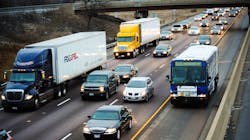FHWA proposed rule would see state DOTs and MPOs self-set emissions targets
The Federal Highway Administration (FHWA) issued a Notice Proposed Rulemaking (NPRM) for states and municipalities to track and reduce greenhouse gas (GHG) emissions. The NPRM is expected to be published in the Federal Register in the next week.
The proposed rule would require state departments of transportation (state DOTs) and metropolitan planning organizations (MPOs) establish both a declining carbon dioxide target and a method for measuring and reporting of GHG emissions.
State DOTs and MPOs would not be mandated by FHWA to meet certain targets but those goals will align with the administration’s commitments outlined in an Executive Order issued on Jan. 21, 2021, which includes the U.S.’s nationally determined contribution under the Paris Agreement. The administration says the proposed rule provides State DOTs and MPOs flexibility to “set targets that are appropriate for their communities and that work for their respective climate change and other policy priorities, as long as the targets would reduce emissions over time.”
State DOTs and MPOs would also be required to report their progress in meeting self-set targets every two years.
“With today’s announcement, we are taking an important step forward in tackling transportation’s share of the climate challenge, and we don’t have a moment to waste,” said U.S. Transportation Secretary Pete Buttigieg. “Our approach gives states the flexibility they need to set their own emission reduction targets, while providing them with resources from President Biden’s Bipartisan Infrastructure Law to meet those targets and protect their communities.”
According to the Environmental Protection Agency, transportation accounts for 27 percent of the GHG emissions in the U.S. with on-road vehicles, which include passenger cars, light-duty vehicles, medium-duty trucks and buses, accounting for more than 84 percent of those emissions.
The Biden Administration pointed to several programs with a combined investment over five years of more than $27 billion included within the Infrastructure Investment and Jobs Act (IIJA) to curb emissions. These programs include more than $81 million in transit and active transport initiatives, including:
- More than $5 billion for the Federal Transit Administration’s (FTA) Low or No Emission Vehicle Program.
- $7.2 billion for the Transportation Alternatives Set-Aside that can help state and local governments carry out environmentally friendly pedestrian and bicycle infrastructure projects.
- FTA’s $69 million Transit Oriented Development (TOD) Program provides funding to local communities to integrate land use and transportation planning with new fixed guideway or core capacity transit capital investment projects. The IIJA also expands TOD funding opportunities through the Transportation Infrastructure Finance and Innovation Act and Railroad Rehabilitation & Improvement Financing programs.
The administration also notes states and local governments can access new and existing formula programs providing critical access to funding to encourage public transportation and other integrated land use and transportation projects and strategies that reduce air pollution by giving Americans more climate-friendly options for travel.
“Every state and local government in this country is seeing the impacts of climate change on their communities and infrastructure. States have a critical role to play as we work nationwide to bring down greenhouse gas emissions and slow those impacts,” said Deputy Federal Highway Administrator Stephanie Pollack. “State laws already require 24 states and the District of Columbia to set targets and track their greenhouse gas emissions and this proposed rule would bring this locally proven approach to scale nationwide.”
----------
The proposed rule can be viewed on FHWA's website.
About the Author

Mischa Wanek-Libman
Group Editorial Director
Mischa Wanek-Libman is director of communications with Transdev North America. She has more than 20 years of experience working in the transportation industry covering construction projects, engineering challenges, transit and rail operations and best practices.
Wanek-Libman has held top editorial positions at freight rail and public transportation business-to-business publications including as editor-in-chief and editorial director of Mass Transit from 2018-2024. She has been recognized for editorial excellence through her individual work, as well as for collaborative content.
She is an active member of the American Public Transportation Association's Marketing and Communications Committee and served 14 years as a Board Observer on the National Railroad Construction and Maintenance Association (NRC) Board of Directors.
She is a graduate of Drake University in Des Moines, Iowa, where she earned a Bachelor of Arts degree in Journalism and Mass Communication.
